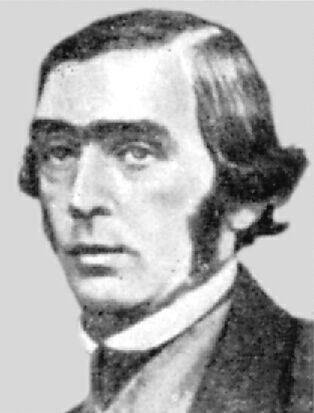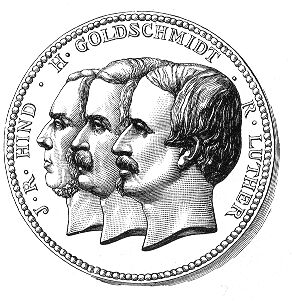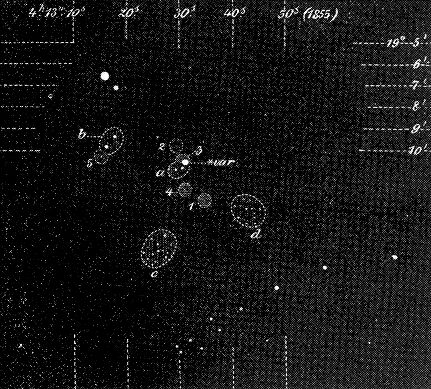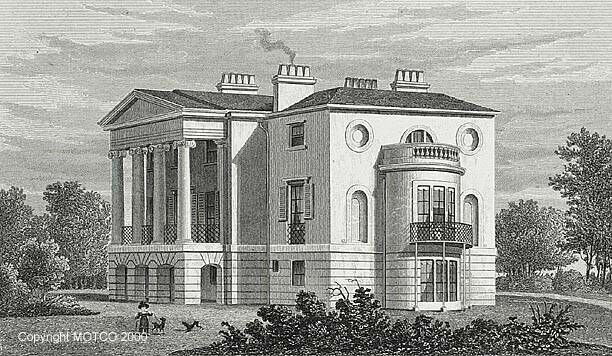 |
 |
Hind was born on May 12, 1823 in Nottingham. He was first an engineer and went to Greenwich Observatory as an astronomer (1840-44). He changed to Bishop's observatory (see below), where he worked from 1844 until 1854. Hind found 4 NGC-objects, 3 were new.
| D | N | NI | Y | M | D | Ap | I | T | Discoverer | Name | Con | Type | S | Author | Title | Source |
| 1 | N | 1555 | 1852 | 10 | 11 | 7,0 | Rr | v | Hind's Variable Nebula | TAU | RN | 2 | Hind, J. R. | Auszug aus einem Schreiben des Herrn Hind an die Redaktion | AN [839] 35, 371 (1853) | |
| 1 | N | 4125 | 1850 | 1 | 4 | 7,0 | Rr | v | DRA | E6/P | 1 | Hind, J. R. | Auszug aus einem Briefe des Herrn Hind | AN [712] 30, 257 (1850) | ||
| N | 6535 | 1852 | 4 | 26 | 7,0 | Rr | v | Herschel W. 24.8.1780 | SER | XI | 5 | Hind, J. R. | New Nebula | MNRAS 12, 208 (1852) | ||
| 1 | N | 6760 | 1845 | 3 | 30 | 7,0 | Rr | v | AQL | IX | 5 | Hind, J. R. | Schreiben an den Herausgeber | AN [549] 23, 351-356 (1845) |
The most remarkable find is NGC 1555 ("Hind's Variable Nebula"), near the variable star T Tauri, both discovered on 11.10.1852. In Astronomische Nachrichten #839 Hind wrote: "Last night (October 11) I noticed a very small nebulous-looking object in A.R. 4h 11m 50s, Dec 19° 08' for 1825.0, the epoch of our ecliptic charts; it was south, preceding a star of 10 mag, which, to my surprise, had escaped intention on the map for 4h R.A. recently published - possibly it may be variable. The sky all the time was remarkably clear, but the object appeared faint; it preceded 1.2s and was 0.7' south of it. I suppose it will prove a new nebula, none of our catalogues having anything in the above position. Its diameter did not exceed 30"." The nebula was found also by d'Arrest in Leipzig (November 1855) with a 4.75" refractor and by James Breen (1826-1866) in 1856 (see AN #1024) with the 12" Northumberland refractor at Cambridge. NGC 1555 is listed as #20 in Arthur Auwers' list of new nebulae in William Herschel's Verzeichnisse von Nebelflecken und Sternhaufen, Königsberg 1862.The story of NGC 1555 and the other variable nebula NGC 1554 (found Nov. 8, 1868 by Otto Struve and later vanishing) near the young star T Tauri is long. Dreyer gave comments in the NGC/IC notes.
 |
W. Tempel's sketch of the T Tauri region (1877). *var = T Tauri. 1 = Hind's position of NGC 1555 (AN 839). 2 = Hind's position based on his description. 3 = Auwers' position. 4 = d'Arrest's position. 5 = Struve's position. a = Tempel's nebulous star. b = Struve's nebula (NGC 1554). c,d = Tempel's star groups.
Hind made some other remarkable discoveries: in October 1847 he found R Leporis ("Hinds Crimson Star"), in the same year the minor planets (7) Iris and (8) Flora and in Dezember 1855 the first dwarf nova U Geminorum. In his career he discovered 10 minor planets, 3 comets and the Nova Ophiuchi 1848. In 1866 he watched the Leonid shower at Twickenham (Bishop's new observatory). Hind was Superintendent of the Nautical Almanac Office from 1853 until his retirement in 1891. He died on December 23, 1895 in Twickenham at the age of 72.
Obituary: MNRAS 56, 200 (1896)
George Bishop (born 21.8.1785 at Leicester, died 14.6.1861 in London) was a rich brewer in London and the head of the largest wine manufactur of British wines in the UK. In 1836 he erected a private observatory near his house, the "South Villa", in Regents Park (famous for its zoo), equipped with a 7" Dolland refractor. He hired the best available observers for his excellent telescope. Apart from Hind there were Eduard Vogel (1851-53), Albert Marth (1853-55), Charles George Talmage (1860-61), Norman Pogson (variable star observer, 1850-51) and the famous double star observer William Rutter Dawes (1839-44). Dawes described Bishop's relationship to his observers: " Mr. B. never did and never could observe at all, not even a transit; but after I left his observatory he put his own name to all my observations!". At his observatory eleven minor plantes were discovered (ten by Hind, one by Marth). Under the direction of Bishop the Ecliptical Charts were made (mainly by Hind), showing stars to 11 mag in a 6° strip along the ecliptic. After closing the observatory due to Bishop's death, the instruments and the dome of the 7" were moved to the residence of his son George Bishop jr. at Meadowbank, Twickenham. A new observatory was erected in the summer 1863. Hind als moved to Twickenham to continue his observations. After its closing of Meadowbank Observatory in 1877 the instruments were given to the Royal Observatory of Naples. In 1857 Bishop served as president of the Royal Astronomical Society.
Obituary: MNRAS 22, 104 (1862); Proc. Roy. Soc. 12, III (1862); AN 139, 255 (1896)
 |
George Bishop (Royal Astronomical Society, London)

